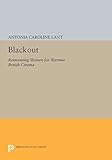Blackout : Reinventing Women for Wartime British Cinema / Antonia Caroline Lant.
Material type: TextSeries: Princeton Legacy Library ; 1206Publisher: Princeton, NJ : Princeton University Press, [2014]Copyright date: ©1991Edition: Course BookDescription: 1 online resource (280 p.)Content type:
TextSeries: Princeton Legacy Library ; 1206Publisher: Princeton, NJ : Princeton University Press, [2014]Copyright date: ©1991Edition: Course BookDescription: 1 online resource (280 p.)Content type: - 9780691600598
- 9781400862191
- 791.43/652042
- PN1995.9.W6 -- L36 1991eb
- online - DeGruyter
- Issued also in print.
| Item type | Current library | Call number | URL | Status | Notes | Barcode | |
|---|---|---|---|---|---|---|---|
 eBook
eBook
|
Biblioteca "Angelicum" Pont. Univ. S.Tommaso d'Aquino Nuvola online | online - DeGruyter (Browse shelf(Opens below)) | Online access | Not for loan (Accesso limitato) | Accesso per gli utenti autorizzati / Access for authorized users | (dgr)9781400862191 |
Browsing Biblioteca "Angelicum" Pont. Univ. S.Tommaso d'Aquino shelves, Shelving location: Nuvola online Close shelf browser (Hides shelf browser)

|

|

|

|

|

|

|
||
| online - DeGruyter Carl von Clausewitz : Historical and Political Writings / | online - DeGruyter Population and Development in Poor Countries : Selected Essays / | online - DeGruyter British Genres : Cinema and Society, 1930-1960 / | online - DeGruyter Blackout : Reinventing Women for Wartime British Cinema / | online - DeGruyter The Epistolary Moment : The Poetics of the Eighteenth-Century Verse Epistle / | online - DeGruyter Aestheticism and Deconstruction : Pater, Derrida, and de Man / | online - DeGruyter Neverending Stories : Toward a Critical Narratology / |
Frontmatter -- CONTENTS -- LIST OF ILLUSTRATIONS -- ACKNOWLEDGMENTS -- LIST OF ABBREVIATIONS -- INTRODUCTION: Cinema in Extremis -- CHAPTER 1. Projecting National Identity -- CHAPTER 2. The Mobile Woman: Femininity in Wartime Cinema -- CHAPTER 3. The Blackout -- CHAPTER 4. Processing History: The Timing of a Brief Encounter -- CONCLUSION. From Mufti to Civvies: A Canterbury Tale -- APPENDIX I. Bogart or Bacon: The British Film Industry during World War II -- APPENDIX II. British Box Office Information, 1940-1950 -- SELECT FILMOGRAPHY -- SELECT BIBLIOGRAPHY -- INDEX
restricted access online access with authorization star
http://purl.org/coar/access_right/c_16ec
The most universal civilian privation in World War II Britain, the blackout possessed many symbolic meanings. Among its complicated implications for filmmakers was a stigmatization of film spectacle--including the display of "Hollywood women," whose extravagant appearance connoted at best unpatriotic wastefulness and at worst collaboration with the enemy. Exploring the wartime breakdown of conventional gender roles on the screen and in the audience, Antonia Lant demonstrates that many British films of the period signaled their national cinematic identity by diverging from the notion of the Hollywood star, the mainstay of commercial American motion pictures, replacing her with a deglamourized, mobilized heroine. Nevertheless, the war machine demanded that British films continue to celebrate stable and reassuring gender roles. Contradictions abounded, both within film narratives and between narrative and "real life." Analyzing films of all the major wartime studios, the author scrutinizes the efforts of realist and melodramatic texts to confront women's wartime experiences, including conscription. By combining study of contemporary posters, advertisements, propaganda notices, and cartoons with consideration of recent feminist theoretical work on the cinema, spectatorship, and history, she has produced the first book to examine the relationships among gender, cinema, and nationality as they are affected by the stresses of war.Originally published in 1991.The Princeton Legacy Library uses the latest print-on-demand technology to again make available previously out-of-print books from the distinguished backlist of Princeton University Press. These editions preserve the original texts of these important books while presenting them in durable paperback and hardcover editions. The goal of the Princeton Legacy Library is to vastly increase access to the rich scholarly heritage found in the thousands of books published by Princeton University Press since its founding in 1905.
Issued also in print.
Mode of access: Internet via World Wide Web.
In English.
Description based on online resource; title from PDF title page (publisher's Web site, viewed 30. Aug 2021)


